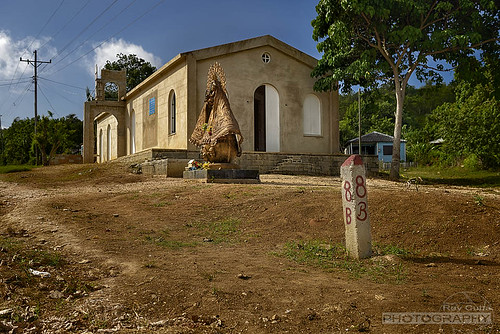Primer asentamiento de la imagen de la Virgen de la Caridad.
La historia se remonta a 1510, cuando el conquistador Alonso de Ojeda arribó a las costas cubanas luego del naufragio del barco pirata, comandado por Bernardino de Talavera, en el que se encontraba como prisionero. De Ojeda, Talavera y la tripulación debieron unir sus fuerzas para comenzar a recorrer la isla a pie buscando volver a La Española —las actuales República Dominicana y Haití—, lugar del primer asentamiento europeo, descubierto por Cristóbal Colón, en 1492.
El camino les deparó hambre y enfermedades, y la mitad de los hombres que acompañaban a de Ojeda murieron. De Ojeda cargaba apenas una imagen de la Virgen María que llevaba consigo desde la primera vez que se embarcó a América, en 1493, e hizo la promesa de que le dedicaría un templo en el primer poblado indígena que encontrara en su camino y que los recibiera con buenas intenciones.
Poco después, con una docena de hombres y el pirata Talavera, llegaron a la comarca de Cueybá, donde el cacique Cacicaná trató amablemente y cuidó a de Ojeda y a los demás hombres, que a los pocos días se habían recuperado.
En agradecimiento, Alonso Ojeda construyó una pequeña ermita con ramas de árboles, posiblemente la primera en suelo cubano. Allí colocó la imagen y cumplió así el voto que había hecho. Enseñó a los nativos a decir el Ave María y aquella expresión se propagó tan rápido que más tarde Cuba se llegó a conocer como la isla del "Ave María".
Sin comprender muy bien la religión, los nativos veneraron la imagen y mantuvieron la ermita con gran esmero cuando Ojeda se marchó.
Más tarde, en 1598, comenzó la explotación del cobre en las montañas de la región oriental de la isla. A 15 leguas de las minas el gobierno español estableció el hato de Varajagua o Barajagua, que contaba con mucho ganado. Por eso era necesaria la sal que prevenía la corrupción de la carne. Así fue como —alrededor de 1612 o inicios de 1613—, dos hermanos y un pequeño esclavo encontraron la estatua de la Virgen flotando en el mar. Se llamaban respectivamente Juan de Hoyos, Rodrigo de Hoyos y Juan Moreno, conocidos por la tradición como "los tres Juanes”.
Desde la aparición de la estatua, la devoción a la Virgen de la Caridad se propagó con asombrosa rapidez por toda la isla y con los años se adquirió un recinto mayor para construir un nuevo santuario que pudiese acoger al creciente número de peregrinos.
La Caridad del Cobre es conocida también como la “Virgen mambisa” por la veneración que le prodigaron los cubanos que participaron en las guerras de independencia de España, a finales siglo XIX, quienes la consideraron un símbolo de patriotismo y de identidad.
La Virgen de La Caridad tiene su santuario nacional en El Cobre, pequeño pueblo cercano a Santiago, a unos 900 kilómetros al este de La Habana.
Tomado de www.miperiodico.com.ar/noticias/virgendelacaridadelcobre....
First settlement of the image of the Virgin of Charity.
The story goes back to 1510, when the conquistador Alonso de Ojeda arrived in the Cuban coast after the shipwreck of the pirate ship, commanded by Bernardino de Talavera , in which he was a prisoner . De Ojeda , Talavera and crew must join forces to start walking around the island looking back to the current Spanish - Dominican Republic and Haiti , site of the first European settlement , discovered by Christopher Columbus in 1492 .
The way they threw up hunger and disease, and half of the men who accompanied Ojeda died. De Ojeda carrying just a picture of the Virgin Mary that led him from the first time I sailed to America in 1493 , and made a promise that I would devote a temple in the first Indian village to find on their way and that the received with good intentions.
Soon after, with a dozen men and the Pirate Talavera, came to the region of Cueybá , where the chief Cacicaná treated kindly and cared for de Ojeda and the other men, who within days had recovered .
In gratitude, Alonso Ojeda built a small shrine with tree branches , possibly the first on Cuban soil . They placed the image and thus fulfilled the vow he had made . He taught the natives to say the Hail Mary and that expression spread so quickly that Cuba later became known as the island 's " Ave Maria " .
Without a good understanding of the religion, the natives venerated the shrine image and maintained with great care when Ojeda went .
Later, in 1598 , copper mining began in the mountains of the eastern region of the island. A 15 leagues mines Spanish government established or Barajagua Varajagua herd , which had much cattle . Therefore it was necessary salt prevented the corruption of the flesh . That was how - about 1612 or early 1613 - two brothers and a small slave found the statue of the Virgin floating in the sea. Respectively were called Juan de Hoyos, Rodrigo de Hoyos and Juan Moreno , known by tradition as the "three Juans " .
Since the appearance of the statue , devotion to the Virgin of Charity spread with amazing speed across the island and over the years it acquired a larger enclosure to build a new sanctuary that could accommodate the growing number of pilgrims.
La Caridad del Cobre is also known as the "Virgin mambisa " by the veneration lavished Cubans who participated in the wars of independence from Spain , in the late nineteenth century , who considered a symbol of patriotism and identity .
The Virgin of Charity has its national shrine in El Cobre , a small town near Santiago , about 900 kilometers east of Havana .
Taken from www.miperiodico.com.ar/noticias/virgendelacaridadelcobre....
9 oct 2013
Caridad del Cobre
Suscribirse a:
Enviar comentarios (Atom)


No hay comentarios:
Publicar un comentario
Comentarios